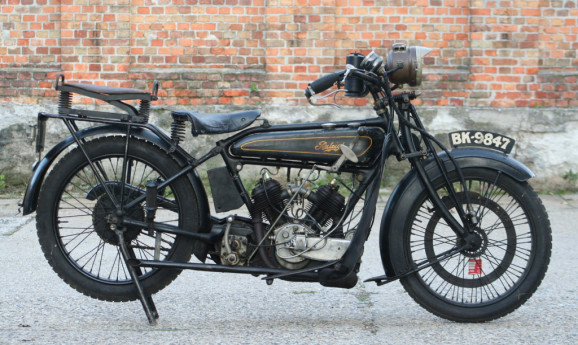
Raleigh Model 12 798cc V-twin 1925 original condition
The Raleigh company was a pioneer in the British motorcycle industry. Company founder Frank Bowden was a firm believer in variable gear systems and from the end of 1902 the Raleigh Cycle company put the Sturmey-Archer cycle hub gear on the market.
Long famed as a builder of pedal cycles, it built its first powered two-wheeler similar to the contemporary Werner in 1899. But its involvement with motorcycles was spasmodic, with long gaps between 1906 and 1919, and between 1933 and 1958. It quit in the mid-1960s, after a dismal period making little 50cc runabouts.In 1924, Raleigh adopted a conventional range of side-valve singles and V-twins that sold well.
The firm produced the famous Sturmey-Archer gearboxes and also supplied engines under the S.A. trademark to other motorcycle manufacturers. In the twenties no less than 8 different engine capacities were produced, sidevalve models as wel as OHV models.
In 1924 the flat twin was discontinued and replaced by a V-twin. Its engine was built up from two 3 HP singles on a common crankcase and was a good example of developing a modular engine range to economize production. Cylinders are set at a 60 degree angle and the machine has a roller bearing big end , mechanical oil pump and of course the typical Raleigh outside flywheel.
The twin was discontinued after 1927 and certainly is not a common sight these days.
8404 MILES IN 12 DAYS.
The longest officially observed trial until that time was that undertaken on behalf of the Raleigh Company in June, 1924, by Hugh Gibson and Miss Marjorie Cottle. The former, with a Raleigh sidecar outfit, under A.C.U. observation, completed a circuit of Great Britain by the coast route, and Miss Cottle, on a solo Raleigh, travelled a similar route in the reverse direction. The total distance wes 8404 miles, and was covered in 12 days. an average of just under 300 miles a day. That was no mean performance for any man and machine, while it was an exceptionally plucky feat for a girl.
Gibson's sidecar machine was a 796 c.c. twin, while Miss Cottle's was a 350 c.c. solo model. All kinds of weather and road conditions were encountered, and the trip stands out as a monument to the reliability of the machines and the pluck of their drivers.
This Model 12, which was a top exhibit at the London Motorcycle Museum for several decades, has been preserved in a rarely found patinated condition. All original small parts have are in beautiful unmolested condition. This example includes the full equipment of Lucas Acethylene lighting set, Cowey 60 mile speedometer, 6 spring luxury pillion seat, large volume footboards and leg shields.




































